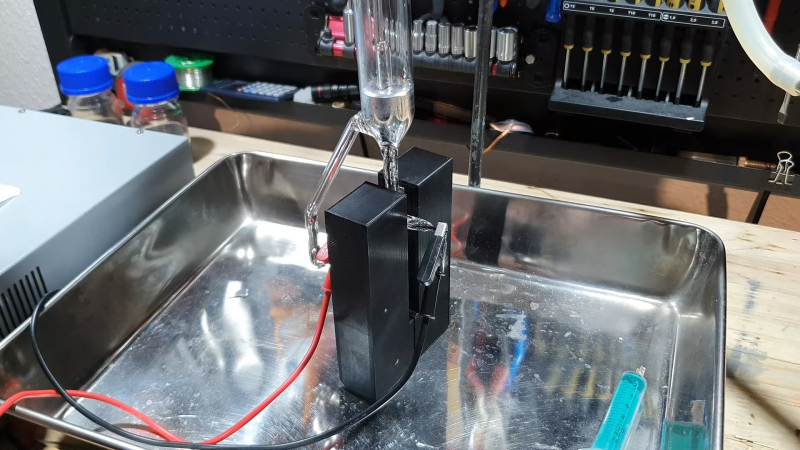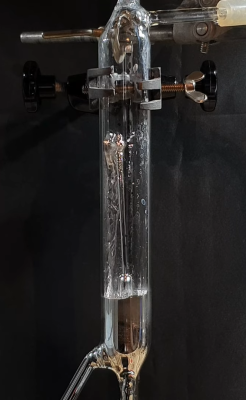
A fountain is a great way of adding a little flair to an otherwise boring pond. All you need is a pump, a filter and some pipes, along with a nozzle to scatter the pressurized water in some aesthetically pleasing way. Fountains are generally quite safe: if any of the parts malfunction, the worst thing that can happen is some minor flooding.
How different this is for [Advanced Tinkering]’s recent project, the NaK Fountain. If this one were to spring a leak, it’s quite likely to take out its surroundings in a huge fireball. That’s because the fluid inside is an alloy of sodium and potassium in about a 1:3 ratio, known as NaK (pronounced like “knack”), which is a liquid at room temperature. Unfortunately, it’s also highly reactive: NaK oxidizes quickly when exposed to air and can even catch fire spontaneously. Contact with water will result in a fiery explosion that scatters corrosive liquids everywhere.
 [Avanced Tinkering] therefore built the whole setup inside a custom-made glass enclosure. In his video (embedded after the break) he shows off his glass-blowing skills to make a small nozzle inside a larger glass tube that acts as a reservoir, with a pipe bringing the liquid back to the nozzle. Also embedded in the glasswork are two tungsten electrodes that serve to implement a rather unusual type of pump.
[Avanced Tinkering] therefore built the whole setup inside a custom-made glass enclosure. In his video (embedded after the break) he shows off his glass-blowing skills to make a small nozzle inside a larger glass tube that acts as a reservoir, with a pipe bringing the liquid back to the nozzle. Also embedded in the glasswork are two tungsten electrodes that serve to implement a rather unusual type of pump.
This magneto-hydrodynamic pump works thanks to the Lorentz force. The two electrodes are used to pass a current through the liquid metal in the x direction, while a pair of neodymium magnets positioned just outside provide a magnetic field oriented along the y axis. The Lorentz force then acts upon the liquid in the z direction, pushing it up through the nozzle. Such a pump is convenient when dealing with highly reactive liquids, because it doesn’t require any moving parts that could leak or corrode.
[Advanced Tinkering] went through a few iterations for his glasswork, trying out different pipe orientations and ways to seal the electodes. A vacuum pump was used to remove all traces of moisture and oxygen, with argon providing an inert atmosphere for the NaK to flow freely without accumulating oxides. The end result is quite impressive: a jet of liquid metal that seems to reach about 15 cm in height.
If you’d like to try this yourself (which we obviously don’t recommend), there’s a reasonably easy way to obtain metallic sodium. You’ll also need to learn some glassblowing, which isn’t as hard as it may seem.
No comments:
Post a Comment